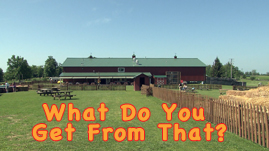Teachers' Domain - Digital Media for the Classroom and Professional Development
User: Preview


KET's Everyday Science is funded in part by Kentucky Power and the American Electric Power Foundation and PNC Bank.
Cows give us the milk we drink every day. We use that milk to make lots of other things we enjoy like ice cream, cheese, butter and cream. In this video, children learn about different animals on a farm and the everyday items we get from them.
This resource is part of the KET Everyday Science collection.
After watching the video, students can use the quiz below as a review. Click the What Do You Get From That? Follow-up Quiz link to get started.
What Do You Get From That? Follow-up Quiz (Interactive)
Many children have pets. They understand that their pets offer them companionship and unconditional love. Building on that interest provides an opportunity for young children to explore what life might be like for other animals, like the animals found on farms, and how those animals contribute to our quality of life.
The following video offers children a chance to learn about farm animals and how they provide food for us to eat and wool to make warm clothes. Understanding the origin of some of products we use every day will help children make connections between their everyday lives and our natural resources.
Exploring these connections at an early age will help children as they build the critical thinking and communication skills they will need for 21st century learning.
sheep, goats, cow, barn, wool, chicken, eggs
The activities listed below may span several days and may be completed in any order that is appropriate for your classroom.
Children will love creating their favorite animals from play dough—especially if you let them help make the play dough using the recipe listed below.
Mix the ingredients and knead with flour. It may take up to one extra cup of flour. If it’s humid, you may have to use more. The recipe will keep for a few days. The dough is flexible, colorful, and has a nice fragrance.
 Loading Standards
Loading Standards Teachers' Domain is proud to be a Pathways portal to the National Science Digital Library.
Teachers' Domain is proud to be a Pathways portal to the National Science Digital Library.
